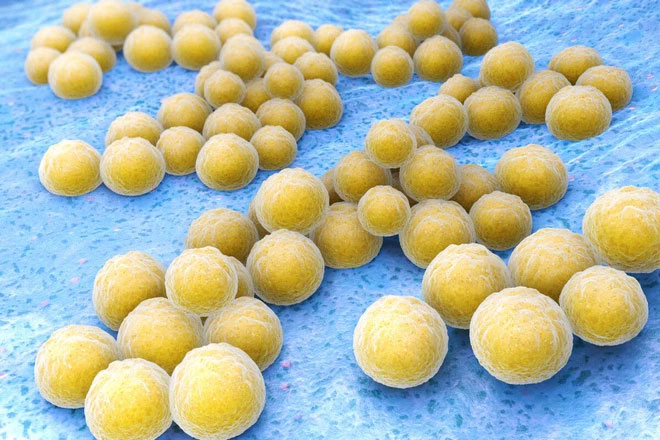Antibiotic-resistant bacteria have become a significant threat to health, not only in the past but also in the decades to come. However, scientists have now discovered that new types of antibiotics may have been inside our bodies for a long time. Researchers at the University of Pennsylvania used a “search” algorithm to uncover dozens of potential antimicrobial peptides hidden within the human body.
Essentially, as bacteria develop increasing resistance to drugs, previously treatable infections can become dangerous again. In fact, it is predicted that these “superbugs” could cause 10 million deaths annually by 2050. With our last line of defense beginning to fail, scientists are searching for new drugs in various places, including green tea, breast milk, rattlesnake venom, frog skin, mushrooms, and even the milk of the platypus.

Staphylococcus aureus is one of the bacteria against which the newly discovered antimicrobial peptides are effective.
In a recent study, researchers attempted to search for new antimicrobial peptides (AMP) in the human body. Peptides are essentially long chains of amino acids produced by the body that serve to synthesize various proteins.
Similar to using a search function to find specific words or phrases in a document, they employed an algorithm to identify peptides with antimicrobial properties in the human proteome. The proteome is likened to a complete library of proteins produced within the body.
The research team began by scanning the proteome for peptides that shared common characteristics with all AMPs—specifically, those ranging from 8 to 50 amino acids in length, carrying a positive charge, and containing both hydrophobic and hydrophilic segments. This search returned 2,603 entries, interestingly none of which were linked to the immune system, leading the researchers to label them as “encoded peptides.”
The researchers then selected 55 of these peptides and tested their efficacy against 8 well-known pathogenic bacteria, including E. coli, Klebsiella pneumoniae, Pseudomonas aeruginosa, and Staphylococcus aureus. Infections from these bacteria are often acquired in hospitals and can be dangerous and difficult to treat.
“We found that 63.6% of the 55 encoded peptides exhibited antimicrobial activity,” said César de la Fuente, the lead researcher. “Interestingly, these peptides not only combat infections from some of the most harmful bacteria in the world, but they also target beneficial symbiotic organisms in the gut and skin. We speculate that this may indicate a regulatory role for the microbiome that these peptides might also possess.”
The AMPs also perform better when grouped with other AMPs from the same region of the body, with their antimicrobial capacity enhanced by up to 100 times. In tests on mice, the research team found that the new AMPs were as effective as existing antibiotics and did not cause any signs of toxicity.
Future testing will examine whether these encoded peptides influence bacteria to develop drug resistance. The results also appear promising.
“What we discovered is that these encoded molecules attack bacteria by permeating through their outer membranes, an essential organelle for survival,” De la Fuente stated. “The ability to penetrate this extremely harmful membrane would require a significant amount of energy and many generations of mutations to develop resistance in bacteria, suggesting that these newly discovered peptides are strong candidates for sustainable antibiotics.”
According to the researchers, this new discovery could not only lead to natural antibiotics to combat the growing threat of superbugs, but the technique used to find them could also help uncover hidden molecules with potential treatments for other diseases.
The research was published in the journal Nature Biomedical Engineering.


















































